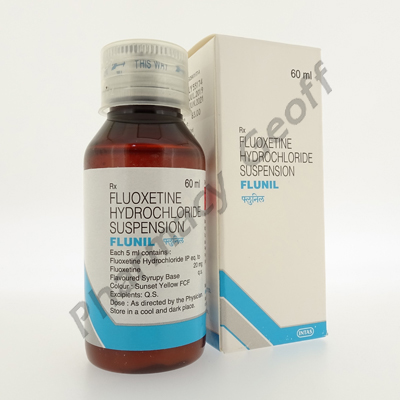Flunil (Fluoxetine Hydrochloride) - 20mg (60mL) Suspension
Uses
Flunil (Fluoxetine Hydrochloride) 20 mg is a drug with antidepressant and anorexigenic effects, belongs to the class of bicyclic antidepressants and selective serotonin reuptake inhibitors. It comes as a suspension.
Flunil (Fluoxetine Hydrochloride) is used to treat depression (especially accompanied by fear), including with the ineffectiveness of other antidepressants, obsessive-compulsive disorders, bulimia nervosa. There is evidence of the efficacy of fluoxetine in alcoholism, anxiety disorders, including sociophobia; diabetic neuropathy, affective, including bipolar disorder; dysthymia, autism, panic attacks, premenstrual syndrome, narcolepsy, catalepsy, obstructive sleep apnea syndrome, kleptomania, schizophrenia, schizoaffective disorders, etc.
Dosage and Administration
Always follow your doctor`s instructions when using Flunil (Fluoxetine Hydrochloride) to get the safest and most effective results from treatment. The dosage is prescribed by the doctor individually for each patient. The usual recommended dose is 20 mg per day, which may be increased if necessary. The maximum daily dose is 80 mg. Doses above 80 mg per day have not been studied.
Flunil (Fluoxetine Hydrochloride) can be used 1-2 times a day, regardless of food intake.
Side effects
The use of Flunil (Fluoxetine Hydrochloride) may cause side effects in some patients including:
-
headache, dizziness, anxiety, nervousness, fatigue, asthenic syndrome, emotional lability
-
tachy- or bradycardia, extrasystole
-
nasal congestion, nosebleeds, sinusitis
-
decreased appetite, anorexia, dry mouth, increased salivation
-
dysuria, rapid urination, nocturia
-
rash, itching
Contact your doctor immediately if you experience any serious or worrying symptoms.
Precautions
Use with caution in old age, with cardiovascular diseases, liver and / or kidney failure.
Careful monitoring of patients with suicidal tendencies is required, especially at the beginning of treatment. The greatest risk of suicide is in patients who have previously taken other antidepressants, and patients who have excessive fatigue, hypersomnia, or motor anxiety during treatment with fluoxetine.
When treating patients with low body weight, the anorexigenic properties of fluoxetine should be considered.
The interval between the withdrawal of MAO inhibitors and the start of fluoxetine should be more than 2 weeks, and the interval between the withdrawal of fluoxetine and the intake of MAO inhibitors should be at least 5 weeks.
Vehicle drivers and people whose activities require an increased concentration of attention and speed of psychomotor reactions must use Flunil (Fluoxetine Hydrochloride) with caution.
During treatment, alcohol should be avoided.
|




